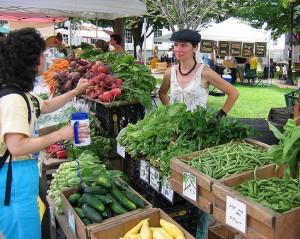 Vermont is seen as a national leader in efforts to use local and regional food systems as an instrument of sustainable community and economic development. Our Farm to Plate Initiative is notable for its legislative backing, broad buy in, and ambitious goals. I have recently been asked if there is an economic justification for public interest and government involvement in food systems. Economic theory can argue it both directions:
Vermont is seen as a national leader in efforts to use local and regional food systems as an instrument of sustainable community and economic development. Our Farm to Plate Initiative is notable for its legislative backing, broad buy in, and ambitious goals. I have recently been asked if there is an economic justification for public interest and government involvement in food systems. Economic theory can argue it both directions:
The con side: Classical economic theory holds that economic efficiency and social welfare are maximized in a market economy: the first fundamental theorem of welfare economics. Any efficient and optimal condition can be reached with markets. Second, it holds that consumers are sovereign: if consumers desire locally grown foods and their ancillary benefits, they will shift their purchases, increase demand, prices will rise, and more suppliers will enter the market without need for government intervention. Third, economists as far back as Adam Smith and David Ricardo point out the gains from trade and specializing in goods for which one is an efficient low cost provider (the idea of comparative advantage). If all of the above are true, any government intervention like Farm to Plate is a waste of money at best and, by advocating for buying more expensive local foods, poses a danger of leaving everyone worse off.
The pro side: The problem with welfare theorems is they do not hold in the absence of perfectly competitive markets, or in the face of any of the following market failures: public goods, external costs, asymmetric information, or market power. In these cases, government intervention is needed to create efficient and just outcomes.
Food systems are rife with examples of each type of market failure. In layperson’s terms, public goods are external benefits everyone can enjoy (like clean air and water and beautiful views), and external costs are harms inflicted on the public (like pollution). Working farm landscapes provide beauty, which contributes to tourism and quality of life, as well as ecosystems services such as water filtration, biodiversity habitat, and carbon sequestration. If this land was to go to its highest short-term value—like shopping mall “development”—these benefits would be lost and we would all lose.
 Local food systems and a healthy farm sector also contribute to community well-being and problem-solving capacity. There is growing evidence that closer connections between farmers and eaters within community-based food systems help to foster improved eating patterns; this potential is increasingly important in combatting the obesity epidemic and its devastating effects on public health. Increased health care costs and their detrimental effects on our economy and business climate are a clear external cost of our current food system. Closer proximity and relationships between farmers, consumers, and other supply chain actors can lead to greater accountability, civic engagement, and stewardship. Moreover, communities with a diversity of farm scales and owner-operated farms are more likely to rate better in a host of measures of social and economic well-being.
Local food systems and a healthy farm sector also contribute to community well-being and problem-solving capacity. There is growing evidence that closer connections between farmers and eaters within community-based food systems help to foster improved eating patterns; this potential is increasingly important in combatting the obesity epidemic and its devastating effects on public health. Increased health care costs and their detrimental effects on our economy and business climate are a clear external cost of our current food system. Closer proximity and relationships between farmers, consumers, and other supply chain actors can lead to greater accountability, civic engagement, and stewardship. Moreover, communities with a diversity of farm scales and owner-operated farms are more likely to rate better in a host of measures of social and economic well-being.
Market power happens when a buyer or seller can demand an unfair price or create barriers to fair competition. A small number of retailers dominate the grocery market; many require slotting fees (in effect paying the store rent for shelf space) which pose huge market barriers for small businesses.
Asymmetric information may be the most compelling market failure of all. Asymmetric information is the case when one economic actor has more information than another. Comparative advantage relies on the key assumption that quality does not matter: the products produced in each region must be identical and completely interchangeable. However, numerous studies have shown that significant numbers of consumers prefer to buy food produced in their community, state, or region. Some of it is based on tangible quality of the product, such as freshness and flavor, while some is based on wanting to support local farmers and economies. Consumer theory states that it is product attributes as well as products themselves that create value for consumers. Without information to express their values and preferences available to consumers, lower priced (and presumably lower quality) products will crowd out higher quality ones in the marketplace and consumer sovereignty is lost.
Admittedly, some of these market failures—information on locally grown—could be addressed by the market. Others, such as maintaining open landscapes for today and future generations, cannot. In the face of the problems wrought by our modern food system (diet-related illness, environmental degradation, and rural community decline) and the potential for local food systems to address them and contribute to vibrant, sustainable communities, agro-ecosystems, and economy, small public investment in efforts like Farm to Plate appear to be well worthwhile.
David Conner is an assistant professor in the UVM Department of Community Development and Applied Economics.
Photo credits:
Burlington Farmers’ Market Wooden Money by Mike Gifford via Flickr CC BY-SA 2.0
Burlington Farmers Market, City Hall Park, Burlington Vermont by Church Street Marketplace via Flickr CC BY 2.0










